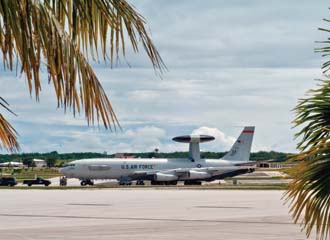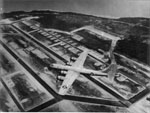Small Island Has a Big Role
 |
An E-3 Sentry airborne warning and control system (AWACS) prepares to taxi out for takeoff in Guam. The AWACS aircraft, from the 552nd Air Control Wing at Tinker Air Force Base, Oklahoma, provides all-weather surveillance, command, control and communications. |
The expansion of the U.S. military presence in Guam is increasing the myriad challenges that U.S. forces face in that remote Pacific island. Guam’s location, time difference and tropical climate are significant factors as the U.S. military there grows in both size and importance.
The 212-square-mile island is seven time zones and more than 3,800 miles from Hawaii, and it falls on the other side of the International Date Line. Guam is the largest and southernmost island of the Marianas Island chain, and as an unincorporated territory of the United States, it supports tactical needs in the region.
“Since Guam is part of the United States, potential operations from here are not subject to foreign government approval or international agreements,” says Brig. Gen. John Doucette, USAF, 36th Wing commander, Andersen Air Force Base, Guam. “Additionally, as [it is]the westernmost part of the United States, Air Force aircraft, personnel and equipment from Andersen Air Force Base can rapidly deploy and respond as needed.”
The island provides the U.S. military a forward base in the Eastern Asia and Western Pacific regions, but its distance from Hawaii and its tropical climate create obstacles for logistic support, communication, personnel and equipment upkeep. Currently, both the U.S. Air Force and U.S. Navy have bases on Guam that are part of Joint Region Marianas. A relocation of some U.S. Marine elements from Okinawa, Japan, to the island is pending.
The 36th Wing hosts deployed bomber and tanker units and also supports fighter unit deployments and large-scale exercises. Past deployments have included B-1s, B-2s, B-52s, F-15Es, F-16s, F-22s, KC-10s and KC-135s. The number of personnel who deploy with these aircraft varies, but typically it ranges from 350 to 800 personnel at any time, Gen. Doucette relates.
Andersen Air Force Base is one of two major military facilities located on Guam that operate jointly as part of Joint Region Marianas, the other being Naval Base Guam located on the southern tip of the island. Joint Region Marianas is a result of the 2005 Base Realignment and Closure (BRAC) commission, which mandated that co-located military facilities from different services operate in more of a joint manner where possible, even to the point of two or more services physically merging and sharing one single base.
Gen. Doucette explains that as part of this effort, the Navy is responsible for all of Andersen’s installation support, such as facilities, vehicle and grounds maintenance; contracting; and law enforcement. Unique within the U.S. Defense Department, this support is executed by Andersen’s Air Force commander on behalf of the Navy. Andersen and Naval Base Guam cooperate closely on myriad installation support issues.
The two facilities maintain different operational postures. “Andersen is a warfighting platform, akin to a Navy carrier strike group, and maintains readiness to conduct operations from and to the base on short notice,” Gen. Doucette explains. “Naval Base Guam is more of a logistic hub that is poised to provide crucial support to the U.S. Pacific Fleet and Defense Department forces operating from, serviced by or supplied through it, as well as for warfighters and their families stationed on Guam.”
While both facilities maintain separate missions, both periodically conduct joint operations, such as Andersen supporting a Navy helicopter sea combat squadron and a strike fighter Ready Aircrew Program for the Navy’s Carrier Air Wing-Five.
Under the Joint Region Marianas construct, the Navy has become the supporting service for base-level communications. While several Air Force mission systems still are maintained under Air Force operational control, portions of land mobile radio, telephone operations and maintenance, cellular telephone and cable services have moved to the joint region program, reports Lt. Col. Freddie Rosas, USAF, commander of the 36th Communications Squadron at Andersen Air Force Base.
While Andersen’s location puts Col. Rosas more than 14 hours away from headquarters, he says the distance is no deterrent to keeping communications both state-of-the-art and at peak preparedness. “We work hand-in-hand with our Air Force higher headquarters,” the colonel explains. “The Defense Information Systems Agency, the Navy, and local communication commercial vendors to provide redundant commercial capability in order to avoid single points of failure.”
 |
A B-29 is shown in flight over Northwest Field, Guam in the 1940s. Records indicate this particular bomber was assigned to the 315th Bomb Wing, 501st Bomb Group. Northwest Field is the original name of the facility known today as Andersen Air Force Base. |
Gen. Doucette acknowledges that Andersen’s location in a remote and isolated part of the world puts it at what he calls “the end of attenuated lines of communication.” Nonetheless, the general says, his base has a long history of supporting large-scale military operations, dating back to B-29 bomber missions during World War II.
The eventual relocation of U.S. military bases and personnel in Okinawa, Japan, to facilities in Guam is another ongoing work in progress for both of the big military facilities. In one case, a Marine air base is expected to relocate to Guam by 2014. “As the identified location for a Marine aviation combat element, Andersen’s role in this transition will be to facilitate that bed-down, and thereby support U.S. policy in the vital Asia-Pacific region,” Gen. Doucette explains. This move is still in question, however, as the United States and Japan tentatively have agreed to build a new Marine Corps Air Facility elsewhere in Okinawa,
Not all military units and personnel will be relocating from Okinawa to other military installations worldwide, and the specifics of that relocation is a continuing process being discussed at the highest levels of the U.S. and Japanese governments, Gen. Doucette reports. As plans are finalized and initially announced for public study and community comment, they continue to change and adjust as needed.
Local officials in Guam have voiced concern that they will not have the financial resources needed to improve local municipal infrastructure, such as roads, water and sewer systems, to accommodate the influx of military personnel linked to the base relocation from Okinawa. Work continues on addressing those needs from the Defense Department side, according to Gen. Doucette. “Any reallocation of forces or adjustment to the mission of Andersen Air Force Base and the 36th Wing is subject to the process described in the National Environmental Policy Act (NEPA). The NEPA process requires us to study, and possibly mitigate, the impact such changes will have on the local environment and community. The process includes solicitation of public comment, which factors into the ultimate decision on the action,” he points out.
“The biggest challenge for Andersen Air Force Base is the same one seen by the rest of the Department of Defense, namely to balance current operations with future requirements to ensure the defense of the United States, maintain peace and stability throughout the region, and ensure U.S. taxpayer funds are used efficiently and wisely,” he emphasizes.
Guam’s location also can present challenges for base personnel when it comes to returning to the continental United States for family leave, Gen. Doucette acknowledges. However, he shares, “Numerous opportunities exist for personnel to travel throughout the Pacific at vastly discounted prices.“
The fact that Guam is a lush tropical island sometimes becomes a reason for individuals to reconsider their length of duty at Andersen. For example, Gen. Doucette proclaims, Guam has “some of the best scuba diving in the world and a wide range of other outdoor activities. Many of the personnel stationed on Guam specifically sought to be stationed here and often extend their tours to stay longer.”
Since the mid-1940s, Andersen Air Force Base has served as the launch platform for countless U.S. military operations, including World War II, the Korean conflict, Vietnam and the Persian Gulf War. It also served as a base for relief operations when 21,000 people were evacuated in 1991 from Clark Air Force Base in the Philippines when the Mount Pinatubo volcano erupted that summer.
WEB RESOURCES
Andersen Air Force Base: www.andersen.af.mil/
Guam Online: www.guam-online.com/military/military.htm
Commander Joint Region Marianas: www.cnic.navy.mil/marianas/index.htm




Comments